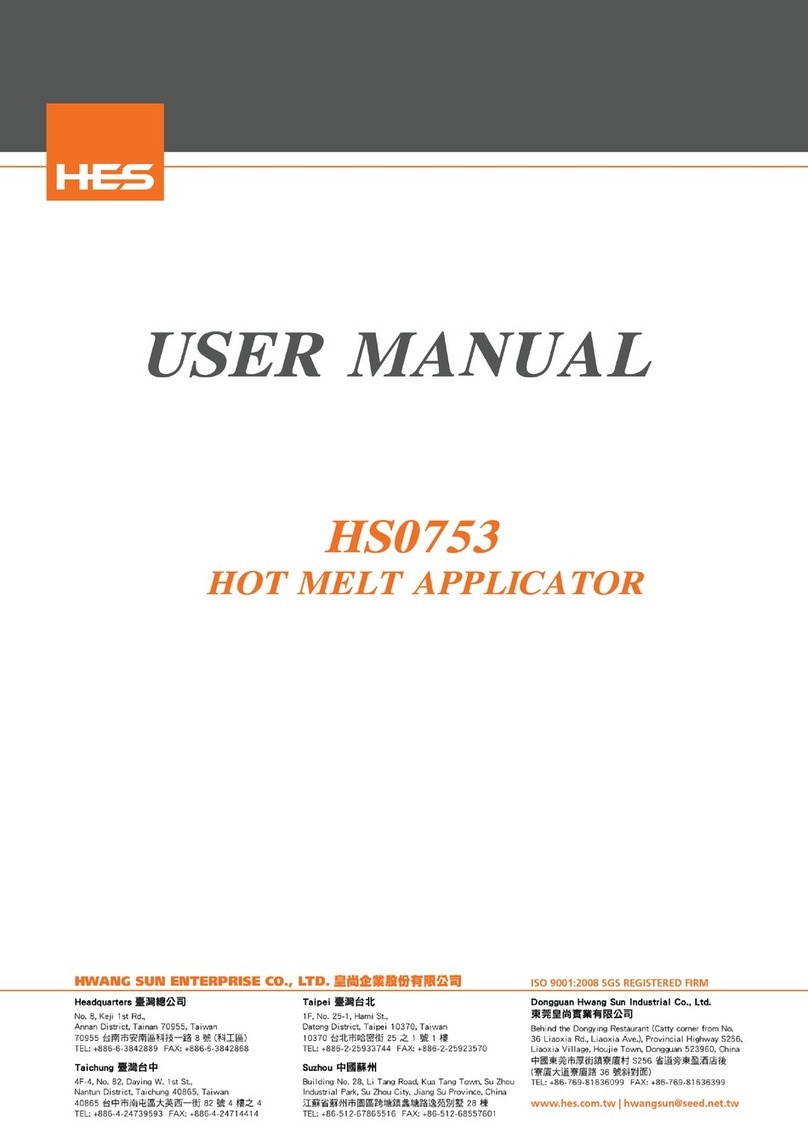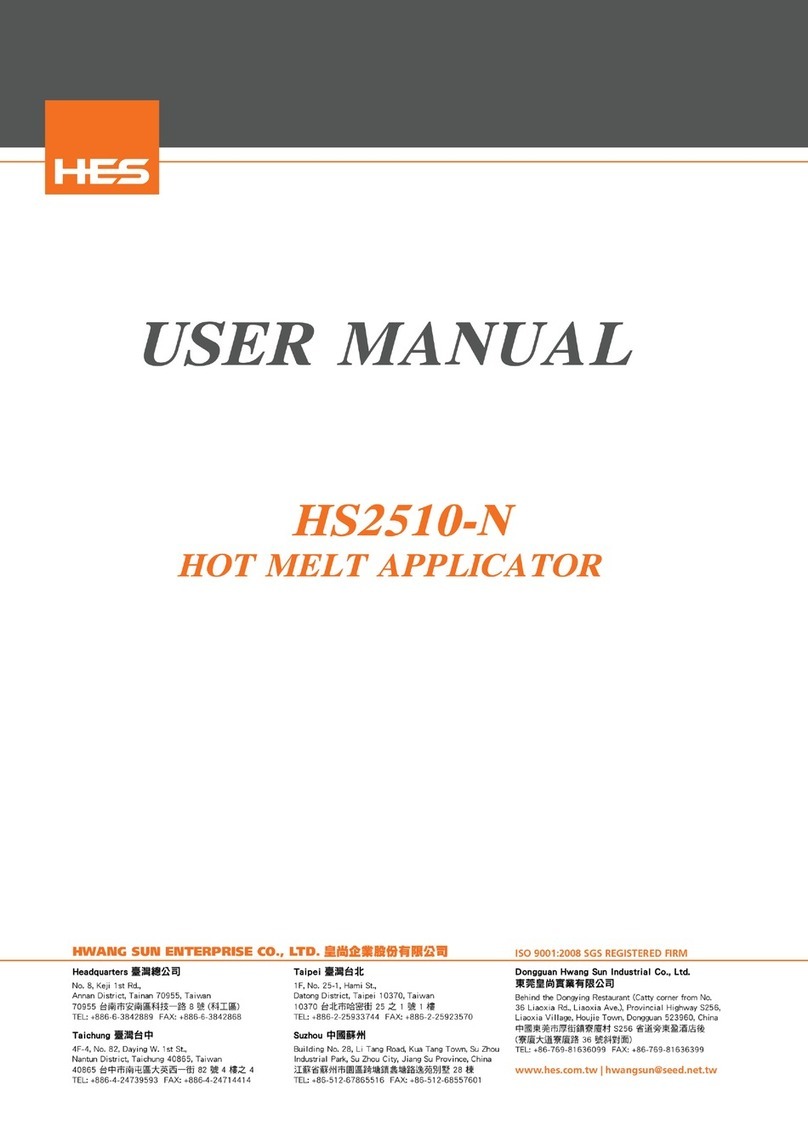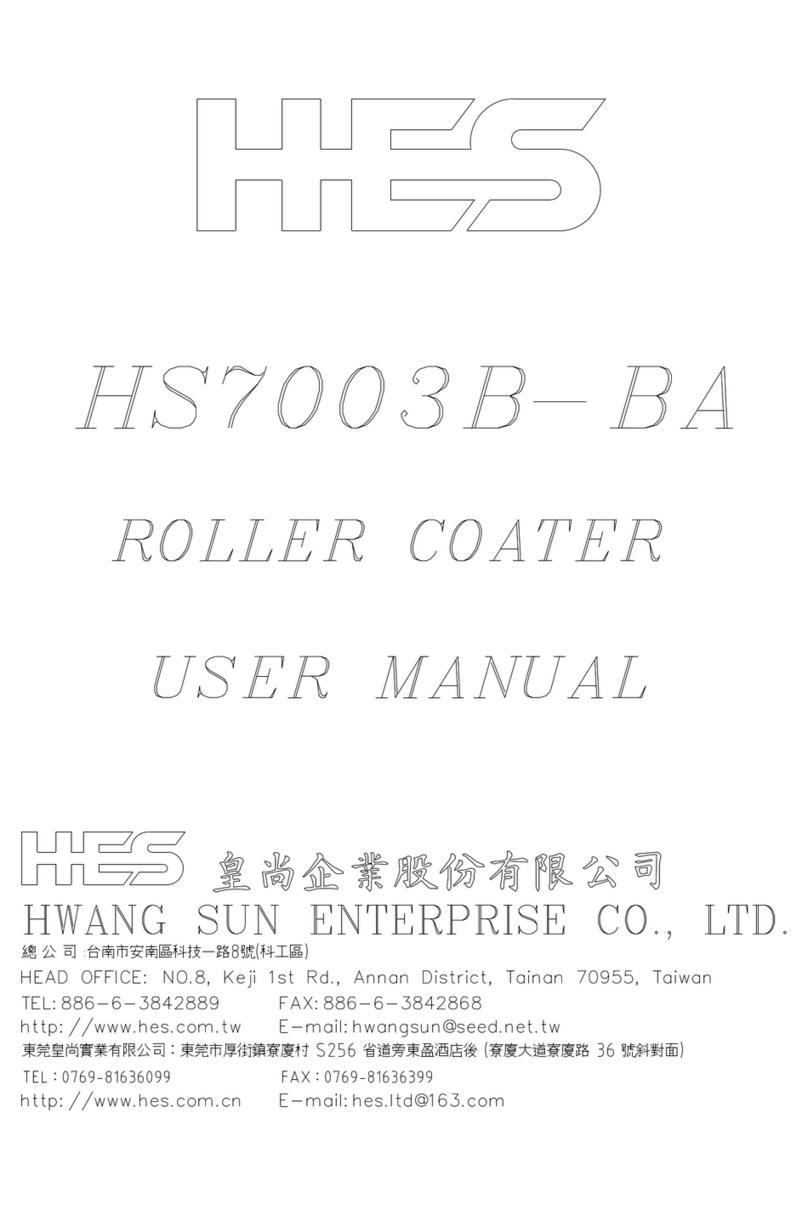HES HS1102S User manual


Hwang Sun Enterprise Co., Ltd. Edition 2012/061
=====
==========
===== CONTENTS =====
==========
=====
CHAPTER 1 SAFETY SUMMARY ................................................................................. 2
1-1 INTRODUCTION
........................................................................................................................... 2
1-2 Safety during installation
................................................................................................................ 2
1-3 Safety during operation
................................................................................................................... 2
1-4 PRECAUTION DURING OPERATION
...................................................................................... 2
1-5 SAFETY DURING MIANTENANCE
......................................................................................... 3
1-6 SAFETY WHEN USING HOT MELT ADHESIVE AND SOLVENT
.................................... 3
CHAPTER 2 OPERATION INSTRUCTION............................................................... 5
2.1 INTRODUCTION
............................................................................................................................ 5
2.2 SAFETY PRECAUTIONS
............................................................................................................. 5
2.3 SPECIFICATION
............................................................................................................................. 5
2.4 MACHINE FAMILIARZATION
................................................................................................... 6
FIGURE 2.1 APPEARANCES OF HS1102S
..................................................................................... 6
FIGURE 2.2 MACHINE DIMENSION (MM)
.................................................................................. 6
FIGURE 2.3 CONTROL-PANEL INSTRUCTIONS
........................................................................ 7
2-5 PREPARATIONS BRFORE OPERATION
................................................................................ 10
2-6 NORMAL OPERATION PROCEDURE
.................................................................................... 12
2-6-1 PROCEDURE OF TURNING ON MACHINE
..................................................................... 12
CHAPTER 3 PREVENTIVE MAINTENANCE
.......................................... 14
3-1 INTRODUCTION
......................................................................................................................... 14
3-2 SAFE PRECAUTIONS
................................................................................................................. 14
3-3 DAILY MAINTENANCE
............................................................................................................ 14
3-4 MONTHLY MAINTENANCE
.................................................................................................... 14
3-4-1 MAINTENANCE OF FILTER ASSEMBLY
......................................................................... 14
3-5 PERIODIC MAINTENANCE
..................................................................................................... 15
3-5-1 GENERAL MAINTENANCE
.................................................................................................. 15
3-5-2 HYDRAULIC SYSTEM CLEANING
.................................................................................... 16
CHAPTER 4 TROUBLESHOOTING
................................................................... 17
4-1 INTRODUCTION
......................................................................................................................... 17
4-2 SAFE PRECAUTIONS
................................................................................................................. 17
4-3 TROUBLESHOOTING OF MECHANICAL AND ELECTRICAL PROBLEMS
.............. 17
CHAPTER 5 DIAGRAMS
.............................................................................................. 21
5-1 INTRODUCTION
......................................................................................................................... 21
5-2 HOW TO USE DIAGRAMS
........................................................................................................ 21

Hwang Sun Enterprise Co., Ltd. Edition 2012/062
CHAPTER 1 SAFETY SUMMARY
1-1 INTRODUCTION
This chapter is to provide related safe precautions while doing installation, operation and
maintenance of HS1102S hot melt applicator to prevent personal and equipment’s risk. These
safe precautions can be classified as following:
1.1 Safety during installation
1.2 Safety during equipment operation
1.3 Safety during maintenance
1.4 Safety during use of hot melt adhesive and solvent
1-2 Safety during installation
1) A correct and effective grounding line must be installed when installing the hot melt
applicator. Without it, any isolation component would still be conductive, resulting in
shock hazard.
2) Check whether the power cords and their isolation protection match requirement according
to the load of the hot melt applicator and its accessories.
3) Ensure that a switch with a thermal safety cut-off is installed between the apparatus and
the primary generator.
4) Ensure that the hot melt applicator is working under the proper voltage. This hot melt
applicator may be burned by using wrong voltage.
1-3 Safety during operation
1) Avoid operating the hot melt applicator near the volatile or explosive materials and gases.
2) DO not operate the equipment without the covers, panels and safety guards properly
installed.
3) Do not operate the machine when the ambient temperature is below 0 or above 50 .℃ ℃
4) To prevent heating hose cannot cool down, please do not put heating hose inside
container.
5) Make sure heating hose is not touched by ground while using longer heating hose.
6) Any cooling on surface of heating hose may cause circumstance that the hot melt glue
inside heating hose get unstable flow.
7) Hot melt glue amount would be affected by dispensing nozzle exposing to ventilation.
(Temperature will instantly cool down)
1-4 PRECAUTION DURING OPERATION
1) Do not use the equipment as a ladder or stepping tools.
2) Prevent heating hose from getting twist and damaged on surface while installation and
operation.
3) Use only the metal base when attempting to lift or move applicator. Do not use

Hwang Sun Enterprise Co., Ltd. Edition 2012/063
equipment’s covers, doors, panels, braces or grips.
4) Do not aim at people while using hot melt handgun.
1-5 SAFETY DURING MIANTENANCE
The main precautions to be adopted when carrying out maintenance are:
1) Disconnect the electrical power supply before maintenance the equipment.
2) Do not wear rings, watches, bracelets, etc. when carrying out the maintenance.
3) Do not in any way to disassemble or adjust any component of equipment unless another
person who can provide immediate assistance is nearby.
4) Only qualified person can do maintenance on the equipment.
5) Do not touch bare connection or component without disconnecting the electrical power
supply while power is on. Dangerous voltage exists at several points in the equipment.
6) Disconnect the power supply before removing any protection case or changing any
electrical components.
7) If possible, please stand on a rubber insulating mat when carrying out maintenance. Do
not work on wet floor or in very damp surrounding.
8) Always wear the protective glasses, clothing and heat-resistant gloves to avoid being
burned by hot surface of components or molten glue.
9) Make sure the operating pressure is reduced to zero before lose or install the pressure
connector.
10) Do not use any tool that is with flaming or a sharp tip to clean melting tank to avoid
damaging the Telfon coating on surface of tank.
11) Please stop operating machine immediately when the air or hot melt glue is leaking out.
And inform the qualified people to maintain.
1-6 SAFETY WHEN USING HOT MELT ADHESIVE AND SOLVENT
A. HOT MELT ADHESIVE
1) The surface of hot melt adhesive would be solidified immediately at normal
temperature. However, molten adhesive inside is still high temperature.
2) Always wear protective glasses, clothing and heat-resistant gloves when load hot melt
adhesive into tank or operate machine close by.
B. SOLVENT
1) Do not use an open flame or uncontrolled heating devices to heat solvents.
2) Do not use solvent that has high volatility to avoid burning and exploding at high
temperature. And this kind of solvent may result poison air at high temperature.
3) Make sure the working area is ventilation enough before use solvents.
4) Do not work under using cleaning solvent for a long time to avoid breathing too much
poison air that caused by high temperature.
NOTICE: If skin is touched by molten hot melt adhesive,

Hwang Sun Enterprise Co., Ltd. Edition 2012/064
1) Do not try to remove the molten adhesive on the skin.
2) Immerse the affected area into cold water until the adhesive is cooled down.
3) Do not try to remove the cooing adhesive from the skin.
4) Wrap the wound with clean and wet clothing. If the condition of injury is very serious,
please keep the patient’s body temperature in normal temperature, and send the patient
to the hospital immediately.
Table of contents
Other HES Industrial Equipment manuals





















